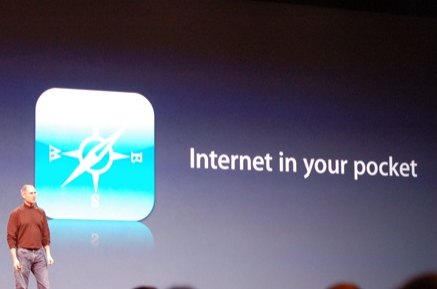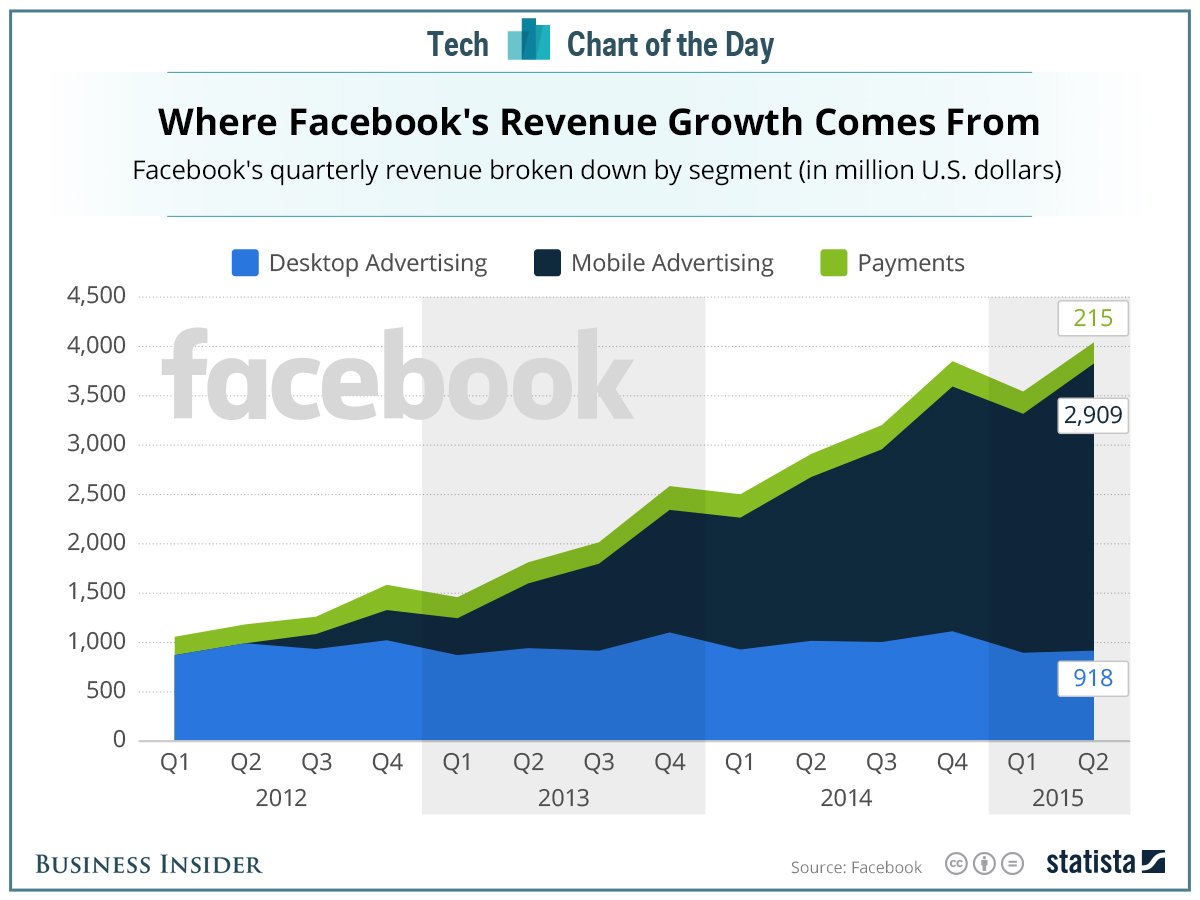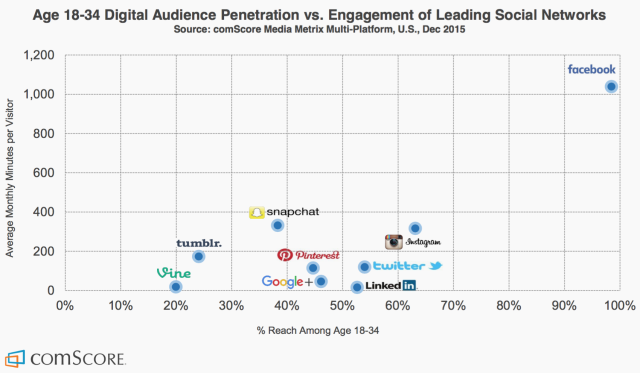B2C
The Future of the Internet Isn’t the Web
Tech products are known for lionizing, buzzword-ridden launches, and the iPhone’s introduction in 2007 was no exception.
“Every once in a while a revolutionary product comes along that changes everything,” said Steve Jobs. “This is a revolution of the first order.”
We’d heard this before. But this time, Jobs was right, and he nailed the reason why in four words: “Internet in your pocket.”

Steve Jobs introducing the iPhone in 2007.
In an article titled “We Are Hopelessly Hooked” for The New York Review of Books, Jacob Weisberg captured just how quickly having the internet in our pockets has changed daily life:
Our transformation into device people has happened with unprecedented suddenness. The first touchscreen-operated iPhones went on sale in June 2007, followed by the first Android-powered phones the following year. Smartphones went from 10 percent to 40 percent market penetration faster than any other consumer technology in history. In the United States, adoption hit 50 percent only three years ago. Yet today, not carrying a smartphone indicates eccentricity, social marginalization, or old age.
When you look at human history from a broader perspective, we’ve become what Weisberg calls a “device people” almost overnight.
The results of the shift are still occurring, and entire industries are being shaken to their core.
The death of the open web and the rise of walled gardens
As mobile quickly began to take over the market, so too did social media platforms like Facebook, Twitter, and Instagram. Rather than surf the web, people increasingly visited individual apps. Facebook saw this trend immediately, and shifted attention and resources to its mobile app.

Mobile ads are driving Facebook’s rapid increase in revenue.
Mobile is now the primary way people across the globe access the internet. More than half a billion people accessed Facebook solely through the mobile app in 2015, according to Facebook. Meanwhile, Facebook’s Free Basics and Google’s Project Loon are spreading across the globe with the goal of connecting underdeveloped countries to the internet, almost exclusively through mobile phones.
Driving this trend is a battle royale between internet giants: Facebook vs. Google, Google vs. Apple, and so on. While Google’s domain is the open web (in which search plays the role of navigator), Apple and Facebook have invested in an internet controlled by apps.
“Websites are unnecessary vestiges of a time before there were better ways to find things to look at on your computer or your phone.” —John Herrman
The app-centric internet seems to be winning—as of 2015, 85 percent of the time users spend on mobile is in apps. As Chris Anderson argues in a 2010 Wired feature called “The Web Is Dead. Long Live the Internet,” “As much as we love the open, unfettered Web, we’re abandoning it for simpler, sleeker services that just work.”
As that 2010 article from Wired suggests, media analysts have seen this change coming for a while. John Herrman, formerly of The Awl and now a fellow at The New York Times, wrote a series of articles called “Content Wars” in which he outlined the implications of a consolidated, platform-centric internet.
The most widely regarded of those articles is titled “The Next Internet Is TV.” In it, Herrman argues that the internet is increasingly taking the form of TV, in which users surf from “channel to channel.” In this case, the channels are platforms like Facebook and Snapchat. The subheading of the piece sums up his argument well: “Websites are unnecessary vestiges of a time before there were better ways to find things to look at on your computer or your phone.”
This transformation accelerated in 2015 and 2016. Facebook’s Instant Articles and its native video player have begun to subsume news and video, respectively. Apple has gotten into the news game with Apple News. And Snapchat’s Discover works with publishers and brand partners to produce platform-exclusive content.
Even Google has tried to adapt to the trend, releasing “accelerated mobile pages” in February in an attempt to match the speed and superior user experience of Facebook Instant Articles while sacrificing some of its commitment to a (relatively) open web. AMP is open to anyone (including brands), and became the default result for mobile search earlier this month—one of the biggest SEO developments in years.
Google also introduced Posts in April, a product that allows select brands and publishers to publish directly to Google’s search results. Instant Articles opened to everyone in April through a WordPress plug-in. Apple News opened to everyone in March.
Facebook has been the main benefactor of this shift from the web to “walled-garden” platforms, as the company’s growth in mobile revenue demonstrates. In general, the past five years have seen a massive shift from web display advertising to social media and mobile advertising.


Facebook’s revenue growth is slowing down, but it still trumps all competitors.
Facebook’s revenue growth has been staggering, and it’s largely been driven by mobile. It’s also part of a larger trend. Social network ad spending has risen dramatically in the past two years and is predicted to only grow more, according to eMarketer.

Social media is the future of digital advertising.
The chat app era
While closed platforms like Facebook continue to dominate, more private forms of communication have also taken hold of people’s attention.
In China, the dominant internet platform is WeChat. In Japan, it’s Line. In Korea, it’s KakaoTalk. In fact, in most of the world, chat apps like WeChat, Line, KakaoTalk, and Facebook Messenger have begun demanding a significant amount of user attention.

Chat apps are quickly taking over.
In the United States, the chat app trend has been slightly impeded by how inexpensive SMS messaging has been. (In many other countries texting is more expensive, so free chat apps had an easy value to pitch to users.)
Snapchat has so far been the most high-profile new challenger in the chat app space. It has cemented its place among the pantheon of Facebook, Instagram, and Twitter as a “must-have” app, particularly among millennials.
Snapchat is a chat app first and foremost, and it’s built for the mobile world. Its primary utility is sending (picture and text) messages to other users. But it quickly expanded, and now has features like Discover, Stories, and Live Stories. Even its navigation separates it from other social network apps, since it relies primarily on swipes rather than taps, and vertical video rather than horizontal video.
For millennials, Snapchat has proven particularly addictive. It’s second only to Facebook in monthly time spent among those aged 18 to 34. Plus, it’s only at 40 percent penetration of the age group, and it’s growing rapidly.

Among millennials, Facebook reigns supreme, but Snapchat and Instagram are on the rise.
Snapchat isn’t the only chat app to quickly penetrate the market and change how people use their phones. Facebook recognized how important chat apps would become in the mobile world, and it has been dumping its resources into Facebook Messenger while also purchasing the massively popular WhatsApp in 2014 (Facebook also attempted to purchase Snapchat in 2013).
It’s become increasingly obvious that Facebook is going to continue to push Messenger hard. Facebook already made a controversial move in 2015 when it separated Messenger’s functionality from the main Facebook app and forced users to download Messenger. It has since surpassed 1 billion users, and is now beginning to bring publishers and advertisers into the fold.
But Messenger goes far beyond content. It has also partnered with companies like Uber to allow users to order cars directly from Messenger, allows for virtual peer-to-peer payments, and envisions that users will soon use the service as a replacement for customer service. It is also developing Facebook M, its disturbingly powerful AI, to make all of this personalized and easy for users. And at this year’s F8 conference, Facebook announced a chat bot marketplace for brands and publishers.
In Europe and Asia in particular, chat apps are already offering similar features.

In Asia, chat apps are at the core of commerce.
In Europe and Asia, chat apps have become central hubs for smart phone users’ lives. It’s where you chat with friends, but it’s also where you shop, order services, and read the news. In fact, chat apps have already emerged as a legitimate alternative to traditional customer service. David Marcus, Facebook’s head of messaging products, used the example of booking a flight, in an interview with Wired UK:
“When you book a ticket, you get a nicely structured message inside Messenger from KLM with your itinerary,” Marcus explained. “You get an interactive bubble when it’s time to check in, and you get your boarding pass, your updates on gates, delays—and if you want to change your flight, you type that in the thread and they do it for you right there and then. Once you interact with a business, you open a thread that will stay forever. You never lose context, and the business never loses context about who you are and your past purchases. It removes all the friction.”
This example is a compelling case for the future of social business. For marketers, getting ahead of this trend will be key. Ultimately, having to operate within walled gardens is inevitable. It’s just a matter of becoming as powerful as possible once you’re inside.
This is an excerpt from “Media 2020: The Marketer’s Guide to the Future of the Internet.” Download the full e-book by filling out the form below.
Get better at your job right now.
Read our monthly newsletter to master content marketing. It’s made for marketers, creators, and everyone in between.




